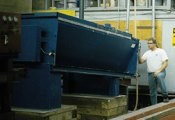Zero-Discharge Recovery
Enviro-Chem recovers precious metals from industrial and commercial wastes...
#sustainability
Enviro-Chem, Inc. is an unusual business. Located in Rogers, Minnesota, the company recovers precious metals from industrial and commercial wastes using a zero- discharge facility.
Roger Meyer and his son Todd were facing a dilemma. Both men are avid outdoorsmen and operate the business in an environmentally conscious manner. The problem was the substantial cost. Each month a tanker load of spent solution was hauled from the facility. To make matters worse, there were trace amounts of gold in the solution that were lost. It was costing the company $2.75 a gallon for disposal of 2,000 gal each month and, in addition, the residual gold could be worth several thousand dollars over a year.
Featured Content
Roger Meyer founded the company after working about 15 years as a chemical process engineer for circuit board manufacturing companies. Mr. Meyer sensed an opportunity providing a service to recover precious metals for circuit board manufacturers. He founded Enviro-Chem, Inc., in 1981 in Minneapolis. Starting with used tanks and baskets in a hand operation, he and his son have built the business into three facilities in Rogers, Minnesota, occupying 31,000 sq ft. The company focuses on customers in the Northern Midwest, providing pickup service in Minnesota, Wisconsin and Iowa.
Process Description. Enviro-Chem's primary source of scrap gold is circuit boards. While recycling scrap circuit boards is the primary source of gold, the company also recovers precious metals from plating solutions, silver-bearing films and even glassware decorated with precious metals.
The circuit boards are processed through a stripping line where the gold and other metals are chemically dissolved from the circuit board. Once the cyanide solution becomes saturated, it will not accept any additional metals. Conventional treatment with chlorine and aluminum is performed to precipitate out the precious metals. This solution is then pumped through a filter press to collect the solids.
The problem for the company was the solution remaining after filtration. The Meyers had evaluated a number of processes, including ion exchange and evaporation, but none seemed to be the best process for Enviro-Chem. The gold and precious metals could be recovered using ion exchange, but that still left the regenerant solution as a disposal problem. Evaporation seemed more encouraging, but there were several drawbacks. When the salt concentrations increased, crystals formed that clogged pumps and spray nozzles. The crystals formed most quickly on the heating elements, restricting heat transfer and creating hot spots. These insulated hot spots are potential points of burn out for the heating elements.
Another problem was the formation of a surface layer or crust that impeded the flow of evaporated water, forming a seal on the surface of the liquid so that moisture could not escape. Although the evaporators evaluated would have reduced the disposal volume, the remaining solutions would still have to be hauled and the gold would be lost.
The Meyers discussed the problem with Mike Boland of O'Beollain and John Michel of Industrial Chemical & Equipment. They suggested a new concept called a Slurry-Mizer from Contaminant Recovery Systems, Inc. (ConRec). This particular piece of equipment was designed for drying liquid slurries with high-solids concentrations. The slurry dryer, designed to handle liquid solutions and to overcome the limitations of atmospheric evaporators, evolved from the company's sludge dryers.
The Slurry-Mizer incorporates a heated, inclined trough with a bi-directional mixing screw that rotates within the trough, mixing the material and keeping the liquid surface broken up for good moisture release. Close-fitting wiper blades are used to prevent buildup on the heated surfaces. Multiple heating zones at different levels minimize potential buildup. Enviro-Chem chose an electrically heated model. Makeup air to carry off the moisture is drawn through the system and exhausted through an existing wet scrubber.
With the new unit, Enviro-Chem processes approximately 1,000 gal per week, reducing the spent solution to a granular material. For maximum productivity, liquid level is maintained full for maximum wetted surface contact. An automatic makeup system, triggered by level sensors, adds slurry automatically.
At the end of the week, the liquid feed is stopped and residual material dried. The dried granules are discharged through a liquid-tight door at the low end of the trough and collected in a pan. This material is then smelted to recover the trace amounts of residual metals. Smelting thermally destroys the cyanide, recovering the precious metals with no hazardous waste. The stripping line runs more effectively since the disposal of stripping solutions allows an earlier cut off before the solution is completely spent, increasing production rates. With the combined savings of the value of the recovered gold and the avoidance of the cost of disposing of the spent solution, Enviro-Chem has recovered its investment in less than a year. Business has increased so much that the company is considering an additional unit.
RELATED CONTENT
-
Coating Plastic Parts More Efficiently
Quality, costs and sustainability in focus with liquid coatings.
-
Is Your Electroplating Waste Hazardous?
Some that bears precious metals is, and there are a host of regulations to consider when recycling.
-
Making Chrome Safe
A non-aqueous hard chrome alternative offers safe and environmentally sustainable functional and decorative chrome coatings.




















